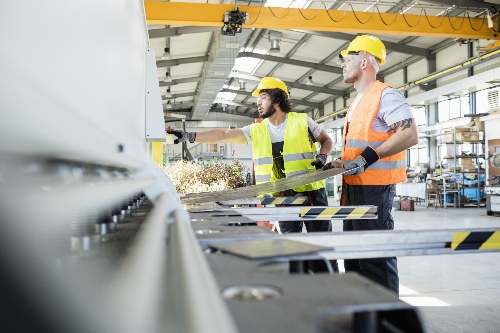Originally posted 4/23/2020. Last updated 4/3/2023.

Sheet metal fabrication provides the crafted and treated materials that surround you. From metal roofing panels and roofing materials to ventilators and gutters, these materials help your property stay protected.
While there are many modern advantages of sheet metal, the process of creating sheet metal parts is not new. This metal fabrication can trace its roots back to Ancient Egyptian and even prehistoric times! Let’s explore some of the most interesting historical metal components and fabrication highlights.
The Early Years of Sheet Metal Design
- 1485 - Leonardo da Vinci, the inventor, sketches a rolling mill to decrease the width and increase the hardness of a metal.
- 1500 - Two reports or rolling mills being used. People used one to create gold coins of similar size. They used the other to make strips of sheets.
- 1590 - People used the rolling mill to press metal together, changing the thickness of the pieces.
- 1615 - Lead and tin plates begin coming out of industrial plants.
- 1682 - England has a cold rolling mill.
The Industrial Age Changes the Sheet Metal Fabrication Process
- 1700 - Hydronics-based systems, used in central heating, research begins in Russia.
- 1715 - Cast iron production begins. Now people can create complex shapes, including rails, round, and square.
- 1760 - The Industrial Revolution brought significant changes. The assembly line and press brake brought new opportunities for workers to mass-produce high-quality parts.
- 1770 - Joseph Bramah developed the hydraulic press.
- 1800 - The Iron Era ends with the invention of aluminum and steam hammers.
- 1857 - Steel production becomes quick and inexpensive with the Bessemer converter.
- 1861 - Unions merge to form the General Union of Braziers and Sheet Metal Workers.
Today: Modern Fabrication
- 1959 - The unions merge again, forming the National Union of Sheet Metal Workers and Coppersmiths.
- 1960 - The Bessemer converter gets replaced by the Basic Oxygen Furnace.
- 1970 - Air bending becomes more mainstream. The process takes less force and uses smaller tools than older methods.
- 2011 - The sheet metal industry grows to 4400 shops in the U.S.
Why History Matters
The history of sheet metal installation and fabrication matters for several reasons:
- Understanding the evolution of metal fabrication techniques can provide insights into the development of human civilization. This fabrication process has been used for thousands of years. As techniques have improved, so have the types of structures and objects that can be created with sheet metal.
- The history of sheet metal fabrication can provide insights into technology development. Sheet metal fabrication has been closely tied to developing metalworking tools and techniques. Advancements in technology have often driven advancements in sheet metal fabrication.
- Understanding this history can help individuals working in the industry better appreciate the skills and techniques developed over time. It can also inspire them to continue to innovate and improve upon existing techniques.
- This history can also provide insight into the social and economic factors that have influenced the industry. For example, changes in demand for sheet metal products have often been tied to changes in the broader economy or shifts in consumer preferences.
Overall, the history of sheet metal fabrication is an integral part of human history. And, it can provide insights into the development of technology, the evolution of human civilization, and the factors that have influenced the industry over time.
Contact JML Sheet Metal Fabrication Today!
Sheet metal fabrication has been a long time in development. This industry continues to grow, adapt, and refine its process to offer better techniques, more complex tools and components, and quicker lead times.
JML Sheet Metal provides high-quality sheet metal materials for cost-effective commercial or residential installation. Check out more of our resources, or call us today to see how we can help you.
Speak to a Pro: (586) 756-4133


